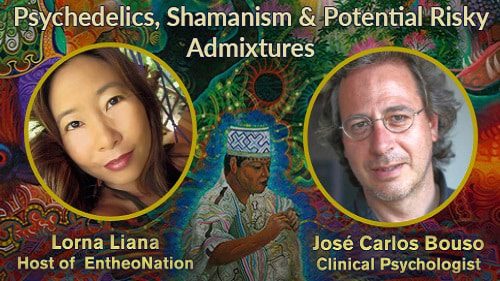Psychedelics, Shamanism & Potential Risky Admixtures with José Carlos Bouso

The scientific director of ICEERS, José Carlos Bouso, joins Lorna to discuss his research with the Center, as well as some shadow aspects to be cautious of in the era of the globalization of ayahuasca.
José Carlos Bouso is the Scientific Director at the International Center for Ethnobotanical Education, Research & Service (ICEERS). He has conducted studies about the therapeutic effects of MDMA (the base compound in ecstacy) and psychopharmacological studies on the acute and neuropsychiatric long-term effects of many substances, both synthetic and as well as plant origin.
In this interview, José Carlos discusses with Lorna the several lines of research he had been pursuing with ICEERS, specifically those regarding:
- The therapeutic effects of medicinal cannabis on patients with chronic illnesses,
- Ibogaine for detoxifying from alcohol and methadone dependence, and
- The psychological processes and potential therapeutic benefits of ayahuasca for first-time takers.
The Downsides of Ayahuasca’s Rapid Expansion
According to José Carlos, ayahuasca is the most sought after psychedelic experience among those seeking healing in recent times. However, while its globalization has brought a lot of transformation to many who have found no solutions in conventional medicine and psychotherapy, the reality is that this expansion has also created some risks allowed by the unregulated nature of the movement.
On this topic, José Carlos singles out a few factors contributing to the potential dangers of neoshamanic ayahuasca use:
The Idealization of Shamanism
Firstly, he argues that the mainstream narrative around Amazonian plant medicine culture tends to idealize this culture on the whole, as well as the healers specifically. Actually, in Amazonian shamanism, the line between good and bad – healing and doing harm – is not as clear as we prefer to believe.
For example, ayahuasca is often used by shamans for spiritual warfare; without a profound and clear understanding of their intentions, one can learn harmful ways from a dark shaman and then propagate them and harm those seeking healing.
Unknowns Serving Unknowns in Places Unknown
Secondly, traditional ayahuasca rituals are conducted in communities, in which the shaman knows all the members they are healing. Extracting ayahuasca from this context of tight community ceremonies and infusing it into groups of people who often don’t know each other and aren’t known by the facilitator takes away this essence of security that comes from mutual closeness.
Additionally, joining ayahuasca ceremonies in unknown, often remote places, with an unknown group and facilitator can be psychologically and medicinally risky to participants.
Novice Shamans & Medical Contraindications
Thirdly, many of the new facilitators don’t go through adequate training and don’t acquire sufficient experience for doing healing work. Not screening participants for medical conditions and pharmaceutical therapies they are undertaking, as well as not knowing what to do in cases of medical emergencies or severe psychological distress are just a few examples of potential risks in these ceremonies emerging in the Global North.
Finally, ayahuasca is a chemically potent concoction, and numerous negative interactions are possible. Conditions such as epilepsy and taking medications such as SSRIs are strongly contraindicated because of a possibility of inducing convulsions or developing serotonin syndrome, respectively.
Questionable Brews
Additionally, while we think we are drinking ayahuasca, recent analyses of brews served in neoshamanic circles in Europe has uncovered that ingredients are often not what they should be, whether for the lack of availability of original plants or for the simple convenience of making brews with analogous substances.
Some facilitators may even include additional ingredients, such as the Brugmansia flower, in their brews, or offer additional substances, such as 5-MeO-DMT, in the ayahuasca retreats. These could result in harm if consumed in improper doses (former) or without enough time in between (latter).
Watch the interview to learn more about:
[+] The emerging neoshamanic use of ayahuasca and the problems associated with the brew’s globalization
[+] Risks of combining ayahuasca with certain medical conditions, prescription drugs, other psychotropic substances, or potentially dangerous admixtures
[+] What you should be aware of if planning to participate in a neoshamanic ayahuasca ceremony.
About José Carlos Bouso
José Carlos Bouso is a clinical psychologist and a doctor of pharmacology, currently working as the director of scientific projects at ICEERS. His areas of interest are psychopharmacology and the therapeutic properties of entactogens, psychedelics and cannabis. He has conducted therapeutic research with MDMA, pharmacological research with several substances of plant and synthetic origin, and has also performed studies on the long-term neuropsychological effects of substances such as cannabis, ayahuasca, and cocaine.
José Carlos authored the book Qué son las drogas de síntesis [What are synthetic drugs?], and co-authored ¿La marihuana como medicamento? Los usos médicos y terapéuticos del cannabis y los cannabinoides [Marihuana as medicine? The medical and therapeutic uses of cannabis and cannabinoids], as well as Ayahuasca y salud [Ayahuasca and health]. His research has been published in scientific journals.
Where to Find José Carlos Bouso
EntheoNation – the process of awakening the Divine within.
Entheo Nation – a global tribe of visionary people living life at the cutting edge of awakening.
EntheoNation is a web show featuring visionaries pioneering the cutting-edge of awakening through psychedelic science, modern shamanism, & new paradigm lifestyles.
Our vision is an environmentally sustainable, socially-just, spiritually-fulfilling, and evolved human presence on this planet, one that integrates ancient wisdom, with modern times.
